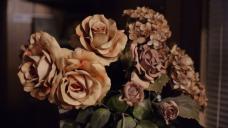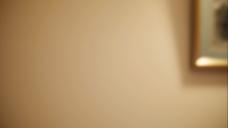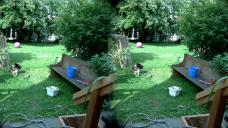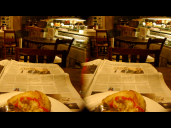
-
@euggie2000 The patch parameters in the Flow Motion 100Mbps MJPEG patch were optimized to maintain high bitrates even in low light conditions, which makes it very good at minimizing banding in areas of dimly lit gradients. One of the best tools for evaluating MJPEG image quality is JPEGsnoop:
http://jpegsnoop.en.softonic.com/
The GH2 records a JPG screenshot file along with each MJPEG MOV file. If you drag the JPG into JPEGsnoop, it will reveal the Quantization Tables used to compress the macroblocks in the file. Here's the luminance table the GH2 used to encode the low light sample video screenshot below, which was recorded with an average bitrate of 88Mbps:
02 02 02 02 07 05 11 11
02 02 02 02 05 09 11 11
02 02 05 05 05 09 16 14
02 05 05 07 11 14 20 20
02 05 07 11 14 16 11 23
09 07 11 14 16 20 16 20
05 14 18 16 20 23 20 18
14 16 18 18 23 23 20 20
The most important numbers in this table are in the upper left corner, and are used in quantizing the most prominent details in the image. Smaller numbers produce higher quality details, but require higher bitrates to encode. For comparison, here's the luminance quantization table Photoshop used to encode the same JPG at its Maximum quality setting:
02 02 03 04 05 06 08 11
02 02 02 04 05 07 09 11
03 02 03 05 07 09 11 12
04 04 05 07 09 11 12 12
05 05 07 09 11 12 12 12
06 07 09 11 12 12 12 12
08 09 11 12 12 12 12 12
11 11 12 12 12 12 12 12
These tables are very similar, indicating that the 100Mbps MJPEG patch can produce videos in low light that are comparable to maximum-quality Photoshop JPEG's.

 Flow Motion 100Mbps MJPEG Patch.JPG1920 x 1080 - 389K
Flow Motion 100Mbps MJPEG Patch.JPG1920 x 1080 - 389K -
@kenoah in low light banding is either absent or very low compared to AVCHD mode.
-
@driftwood frames were 1920x1080, these pictures are the screenshots.. Which Quantum mjpeg settings do you recommend to adjust? I am curious if it's possible to raise DR, is there any way to get some kind of the effect in the Nostalgy mode. RED cameras shots show the better shadow details, is it because of the auto hdr shooting?
-
@Euggie2000 are you saying in low light situations mjpeg has no banding?
-
Try some of the Quantum mjpeg settings but adjust the frame sizes back to 1920 x 1080 and 720 x 1280. See if you can get further improvements than the 100M setting you used.
-
@Frame I can confirm - the MJPEG doesn't suffer of banding problem, as opposed to AVCHD. I've attached two sample screenshots (ISO 320, F0.95, intentional out of focus). I know, these are jpegs, but anyway. First one (Driftwood, GOP1, 174mbits/s) has concentric bands around the picture on the wall, and the second (MJPEG. 100mbits/s) one just doesn't have this problem at all. I think this is all about compression methods of the two very different formats. Previously I was really disappointed that even best available hack doesn't fix the banding issue that I face everytime when I shoot in the darker places with the smooth/gradient background. After I tried the Mjpeg mode I was really surprised in a good way. So here's the workaround for me. If I need to shoot in such environment as in the samples I'd use MJPEG, otherwise - AVCDH would be the choise, most of the time.

 gh2_dw_174_banding.jpg1366 x 768 - 71K
gh2_dw_174_banding.jpg1366 x 768 - 71K
 gh2_mjpeg.jpg1366 x 768 - 64K
gh2_mjpeg.jpg1366 x 768 - 64K -
Having the SLR-Magic 0,95 Lens for some days, I get problems with banding because of soft backgrounds and gradients. The 1920x1080 MJPEG Patch shows lesser banding compared to to the best AVCHD-Patch. I guess, it is because of higher noise. Almost no blocking/mudding in darker areas with MJPEG!! A BIG MUST: Having the ability to record 16bit PCM in 48.000kHz, or at least AC3. Quicktime player shows 16.000kHz sampling frequency in my MJPEG recordings. So audio is not usable. See: http://www.personal-view.com/talks/discussion/492/eoshd-crusade-on-mjpeg-hacks/p2 All the best, Frame
-
I've been experimenting with small resolution increments, just for 16:9, which some seem to work so far without lowering the quality settings Driftwood provided.
The hope is, it down sizes from full size sensor image -> x by y, and stores that, so the idea is to shoot slightly wider than I need for the odd clip that I want to process through Deshaker for some more stability, so that it can crop without (or even less) loss of detail/sharpness for 1080p. -
do you mean that the viera tv stretches it on its own?
-
@fatpig Try sticking it on a panny viera screen and its vertically squashed (side by side 3D). You can work on it in an NLE/post and sort it but I was attempting to change the sizing incamera so I didnt have to do that (of course this was purely for me and other viera/3D TV owners). We may need a new thread to discuss this further.
-
I really don't know what you are seeing. look at the picture- straight out of the cam. look at the ball. this is the image the lens produces. there is no wrong aspect ratio in it. it is like this. 2 perfectly unstretched images side by side, but one not as large as the other one, due to mechanic incorrectness of the production process.
Nothing to stretch in post here.
 3dgh2.jpg1920 x 1080 - 438K
3dgh2.jpg1920 x 1080 - 438K -
@fatpig Ive been trying to understand what the exact resolution required to pull it out under mjpeg mode without having to resize and be abe to play it straight back off the sd card plugged into a viera tv. Its unusable and yes very sad.
Barrry Green's article was fairy helpful but working out the dimensions pre NLE is taking a lot of testing. I think youre probably right even though its not an anamorphic lens (see lpowell and B Greens findings) there may well be a way of blowing it out properly. Presently its too wide so you mess with the vertical res and then you one image sitting inside the other.... tres difficult... looks like post is the only way to do it for now unless anyone can find a suitable adapter. -
on the 3d lens...
I have it, and its 2 pictures in about 3:4 aspect, which already have the correct aspect ratio, which is horrible and unusable for movies. and to make matters worse: the dividing "line" is not in the center, but some 40 pixels off.. its really sad.
maybe with an anamorphic adapter that is really wide one could at least get 16:9? -
Definite effect on chrominance on E1/F1.
-
@driftwood
Nope, wasn't me. My hunch is the chroma tables are hard wired with the luma tables. -
@LPowell Did you mention in the past that E1/F1 was chrominance and E4/F4 was luminance?
-
@driftwood
Not sure what you mean, the MJPEG encoder has four patchable sets of Tables and Quantization factors that determine how it encodes each macroblock. Table 4 produces the highest detail and I suspect its elements are all set to one, or something very close to that. Tables 0-3 are dysfunctional and produce blank macroblocks. The first attempts at high bitrate patches on the GH1 used nothing but table 4, and as you might imagine, this type of brute force approach produces very inefficient MJPEG encoding that wastes bandwidth and emphasizes edge artifacts. -
@LPowell Been reading here, Why don't you let the encoder choose the Quant tables? If the Quality is high enough...
-
@driftwood sorry to be a pain about the quality of the image- but considering how dar it would have been- and the fact that this lens is a Daylight lens --- GOOD JOB!
-
*** 100mbps PAL*** Just came across this Post and read opening statement on the patch..L Powell says this patch is NTSC & PAL...I am GH13 X 8 user and yet to get the GH2 as I thought the PAL side was a dead duck...
Can I get this 100mbps MJPEG patch @ 720P25, 720P50 or 1080P25 or am I still sobbing in the dark...
Many thanks
Truestory -
Forget the piccie quality - its spanmybitchup hi iso, testing out in a v dark cafe - for the record - just trying to check frame sizes.
-
Lots of macro-blocking on the chairs... what settings did you use to record the dinner?
-
@LPowell I sort of dont wanna be beaten by this bleedin panny 3D lens until I can at least get a decent workflow going and it seems like your mjpeg stuff could make summit happen. So, lets see if anyone can help.
If you record in AVC 1080p24 you have two split images contained in 1920 x 1080 and squeezed as shown in image. So this is two 960 x 1080 pictures for Left and Right.
The problem is you cant just stick it into a Viera 3D TV cus the resultant image is squashed, its like widescreen acting on widescreen. You cant correct aspect ratio on a 3D image with these TVs.
So I need to rip out each side in an editor OR record in a correct aspect ratio which could mean squeezing even more out of the picture using mjpeg so that will 16:9 or whatever best scales to the TV. What would you suggest? Im wondering if 1440 x 540 might crack it.

 3d Sequence 02-1.png1440 x 1080 - 2M
3d Sequence 02-1.png1440 x 1080 - 2M -
Forget about syncing - I know of stories where (and VK has posted this recently) regarding 2 lenses that just didn't sync due to construction. The focus was out- the barrels everything.
So its not just Hightech sync - its also low tech as well, (well not low tech -but you get the idea)! And with 3D you have to get EVERYTHING in... or pay a mastering house heaps of cash- whatever you prefer... they can even convert now- and its getting cheaper! -
@alcomposer yep, there's no simple solution/cheap option, but I'm sure we're going to get a few lens manufacturers attempting summit. Syncing 2 gh2s with identical lenses is not for the faint-hearted.
Howdy, Stranger!
It looks like you're new here. If you want to get involved, click one of these buttons!
Categories
- Topics List23,991
- Blog5,725
- General and News1,354
- Hacks and Patches1,153
- ↳ Top Settings33
- ↳ Beginners256
- ↳ Archives402
- ↳ Hacks News and Development56
- Cameras2,367
- ↳ Panasonic995
- ↳ Canon118
- ↳ Sony156
- ↳ Nikon96
- ↳ Pentax and Samsung70
- ↳ Olympus and Fujifilm101
- ↳ Compacts and Camcorders300
- ↳ Smartphones for video97
- ↳ Pro Video Cameras191
- ↳ BlackMagic and other raw cameras116
- Skill1,960
- ↳ Business and distribution66
- ↳ Preparation, scripts and legal38
- ↳ Art149
- ↳ Import, Convert, Exporting291
- ↳ Editors191
- ↳ Effects and stunts115
- ↳ Color grading197
- ↳ Sound and Music280
- ↳ Lighting96
- ↳ Software and storage tips266
- Gear5,420
- ↳ Filters, Adapters, Matte boxes344
- ↳ Lenses1,582
- ↳ Follow focus and gears93
- ↳ Sound499
- ↳ Lighting gear314
- ↳ Camera movement230
- ↳ Gimbals and copters302
- ↳ Rigs and related stuff273
- ↳ Power solutions83
- ↳ Monitors and viewfinders340
- ↳ Tripods and fluid heads139
- ↳ Storage286
- ↳ Computers and studio gear560
- ↳ VR and 3D248
- Showcase1,859
- Marketplace2,834
- Offtopic1,319






